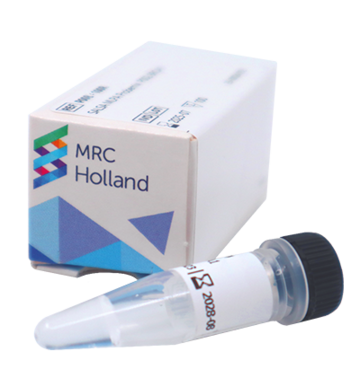The SALSA MLPA Probemix P054 FOXL2-TWIST1 is a research use only (RUO) assay for the detection of deletions or duplications in the TWIST1, FOXL2, FOXC1, FOXC2, ATR, PITX2, PISRT1 and GPR143 (former OA1) genes, which are associated with ophthalmogenetic anomalies.
The protein encoded by the TWIST1 gene may affect the transcription of fibroblast growth factor receptors (FGFRs), a gene family implicated in craniosynostosis. It is suggested that TWIST1 proteins also regulate cytokine signalling. The TWIST1 gene is located on chromosome 7p21.1, contains two exons and spans only ~2.2 kb. Mutations in the TWIST1 gene are the major cause of Saethre-Chotzen syndrome (SCS; OMIM 101400). It has been estimated that 23% of SCS patients have a deletion of one copy of the TWIST1 gene. The majority of patients with a TWIST1 deletion are also developmentally delayed, presumably due to haploinsufficiency of nearby genes. The P054-C3 FOXL2-TWIST1 probemix contains two probes for the TWISTNB (POLR1F) gene, located at a distance of ~580 kb from TWIST1 in a relatively gene-poor region. There is no clear evidence yet, however, that a deletion of TWISTNB is the cause of the developmental delay. More information about SCS is available at https://www.ncbi.nlm.nih.gov/books/NBK1189/.
The FOXL2 gene encodes a forkhead transcription factor. Mutations in FOXL2 can cause blepharophimosis syndrome (BPES; OMIM 110100), an autosomal dominant syndrome characterised by eyelid malformation, sometimes associated with premature ovarian insufficiency (BPES type I), and sometimes not (BPES type II). The FOXL2 gene is located on chromosome 3q22.3 and consists of a single 2.7 kb exon. Several FOXL2 deletions have been identified. The deletions can span several Mb of chromosomal DNA and may extend to the ATR gene located 3.6 Mb telomeric of FOXL2 (D'haene et al. 2010). Three probes for ATR are included in this probemix. The non-protein-coding PISRT1 gene is located on 3q23 and consists of a single 0.5 kb exon. PISRT1 is located 0.3 Mb telomeric from FOXL2 and shares a common transcriptional regulatory region with FOXL2. More information about BPES is available at https://www.ncbi.nlm.nih.gov/books/NBK1441/.
Other genes detected by this probemix are PITX2 (4q25, Axenfeld-Rieger syndrome; OMIM 180500), GPR143 (Xp22.2; ocular albinism type I) and the forkhead transcription factors FOXC1 (6p25.3) and FOXC2 (16q24.1).




